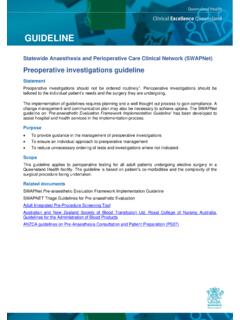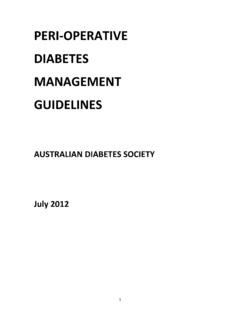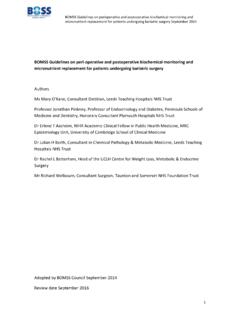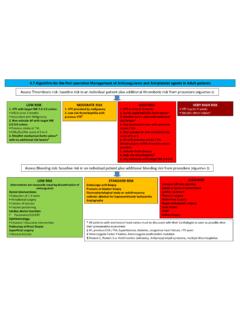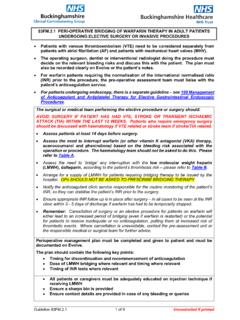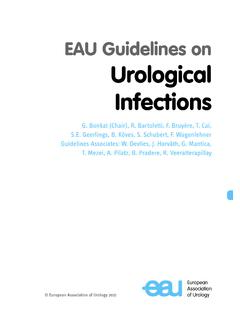Transcription of EDITION 2021 GUIDELINES FOR THE MANAGEMENT OF …
1 2021 GUIDELINESFOR THE MANAGEMENTOF TRANSFUSION DEPENDENTTHALASSAEMIA (TDT)PUBLISHERS THALASSAEMIA INTERNATIONAL FEDERATION 4TH EDITI ONEDITORS: Cappellini, , , , GUIDELINES FOR THE MANAGEMENT OF TRANSFUSION DEPENDENT THALASSAEMIA (TDT)PUBLISHERS THALASSAEMIA INTERNATIONAL FEDERATIONEDITORS:Cappellini, Farmakis, D. Porter, J. Taher, FOR THE MANAGEMENT OF TRANSFUSION DEPENDENT THALASSAEMIA (TDT)Table of ContentsEditors, Authors, Reviewers, AffiliationsForeword The need for GUIDELINES and their implementationClass of Recommendation_Level of EvidenceChapter 1: Genetic basis, pathophysiology and diagnosis of thalassaemias Haemoglobin types Globin genes The thalassaemias 1. Pathophysiology of thalassaemia 2. Diagnosis of thalassaemia 3. Structural haemoglobin variants 4. Diagnosis of thalassaemia 5. Pathophysiology of thalassaemia 6. Summary 7.
2 RecommendationsChapter 2: Blood transfusion Aims of Blood Transfusion Haemovigilance Blood donation Blood component specification Storage of Donor Red Cell Units Compatibility Testing Criteria for initiating transfusion therapy Transfusion thresholds and frequency Volume to be transfused Rate of transfusion Transfusion and the spleen Adverse Reactions Summary and RecommendationsChapter 3: Iron overload: Pathophysiology, diagnosis and monitoring The Rate of Iron Loading Toxicity from Iron Overload Monitoring of Iron Overload Summary, Recommendations and Grade of EvidenceChapter 4: Iron chelation Aims of iron chelation therapy Sources of chelatable (chelateable) iron Chemical and pharmacological properties of licensed chelators3 TABLE OF CONTENTS Practical prescribing of individual chelators i. Deferoxamine monotherapy ii. Deferiprone monotherapy iii.
3 Deferasirox Combination therapies Which chelation regime, when and how much? Summary, Recommendations and Grade of Evidence Appendix 1 - Licensed indications, and precautions for chelation in thalassaemia. Appendix 2 - Unwanted Effects of Iron Chelators Appendix 3 - Practical Issues with DFO InfusionsChapter 5: Cardiovascular disease Introduction Pathophysiology Forms and phenotypes Assessment and monitoring Prevention and treatment Summary and RecommendationsChapter 6: Liver disease Introduction Hepatic Iron Overload Viral Hepatitis Hepatocellular Carcinoma Summary Recommendations and grade of evidenceChapter 7: Growth abnormalities Introduction Diagnosis and investigations Annual growth screening Treatment Summary Short statement and grade of evidence Chapter 8: Endocrine disease Introduction The prevalence of different endocrine-related complications Delayed Puberty and Hypogonadism Hypothyroidism Impaired Glucose Tolerance (IGT) and Insulin-dependent Diabetes Mellitus (IDDM) Hypoparathyroidism Adrenal Insufficiency Summary Short statements and level of evidence4 GUIDELINES FOR THE MANAGEMENT OF TRANSFUSION DEPENDENT THALASSAEMIA (TDT)Chapter 9: Infectious disease Introduction Therapy-Related Risks of Infections in TDT and Preventive Measures i.
4 Transfusion-transmitted infections ii. Transfusional Iron overload iii. Splenectomy iv. Iron chelation therapy Disease-Related Risks of Infections in TDT and Preventive Measures Infectious Agents in Thalassaemia Diagnosis and Treatment i. Bacterial infections ii. Viral infections iii. Fungal infections iv. Parasitic infections Summary and RecommendationsChapter 10: Bone disease Introduction Pathogenesis Bone Markers Recommendations for the prevention and treatment of early bone loss Medical treatment Summary and RecommendationsChapter 11: Dental Care Oro-facial Features Risk Assessment for Delivery of Dental Care Practical ManagementChapter 12: Splenomegaly and splenectomy Introduction Indications for Splenectomy Splenectomy and Peri- operative Complications Adverse Events of Splenectomy i. Sepsis ii. Chemoprophylaxis iii. Hypercoagulability iv.
5 Pulmonary hypertension v. Iron overload Summary and Recommendations with Grade of EvidenceChapter 13: Fertility and Pregnancy Introduction MANAGEMENT of Subfertility in Females Methods for induction of ovulation Male Fertility and Induction of Spermatogenesis Pre-Pregnancy Counselling i. Evaluation of eligibility ii. Review of medications iii. Risks Associated with Pregnancy5 TABLE OF CONTENTS MANAGEMENT of Pregnancy Managing delivery Postpartum care Summary and RecommendationsChapter 14: Lifestyle and quality of life Introduction Exercise and Participation in Sports Education Employment Marriage and Reproductive Life Nutrition Anti-oxidant therapy Supportive Treatments Quality of Life Summary and RecommendationsChapter 15: Psychological support The Challenge of Psychological Support Practical Considerations Transition to adult care Pain in thalassaemia patients Non-Adherence to Chelation Therapy Psychosocial support throughout the lifespan as part of standard care Summary, Recommendations and Grade of EvidenceChapter 16: Hematopoietic Stem Cell Transplantation for thalassaemia Introduction Risk class approach for patient and protocol selection i.
6 Pre-transplant evaluation HSCT from HLA-matched sibling donors (MSD) HSCT from HLA-matched unrelated donors HSCT from phenotypically matched related donors i. Haploidentical HSCT ii. Mixed chimaerism following HSCT for thalassaemia Adult thalassaemia patients Follow up after HSCT Cost and cost effectiveness Summary and RecommendationsChapter 17: Gene therapy for thalassemia Introduction Gene therapy by gene addition Gene therapy by Gene editing Gene therapy clinical trials The long-term safety of gene therapy Regulatory approval and marketing authorization The current challenge of applying gene therapy Summary and Recommendations 6 GUIDELINES FOR THE MANAGEMENT OF TRANSFUSION DEPENDENT THALASSAEMIA (TDT)Chapter 18: Novel and Emerging Therapies Targeting Ineffective Erythropoiesis and Iron Dysregulation Basic recommendations regarding the use of ReblozylChapter 19: The value of patients engagement Introduction How engaging patients can be of benefit Who are really patient advocates?
7 TIF and its work on patient involvement Conclusion Chapter 20: Multidisciplinary Care and Reference Centres in addressing haemoglobin disordersMonitoring - Summary Table Index 8 GUIDELINES FOR THE MANAGEMENT OF TRANSFUSION DEPENDENT THALASSAEMIA (TDT)EDITORS, AUTHORS, REVIEWERS AND AFFILIATIONSEDITORS AND AFFILIATIONSP orter John, Department of Haematology, University College London Hospitals NHS Foundation Trust, London, Ali, Department of Internal Medicine, American University of Beirut Medical Center, Beirut, Lebanon. Cappellini Maria Domenica Department of Medicine and Medical Specialties, Istituto di Ricovero e Cura a Carattere Scientifico (IRCCS) Ca Granda Foundation Maggiore Policlinico Hospital, Milan, ItalyFarmakis Dimitrios, University of Cyprus Medical School, Nicosia, Cyprus. AUTHORS, REVIEWERS AND AFFILIATIONSAli Alassaf, University of Oklahoma.
8 Executive Director, American Institute for Healthcare QualityAngastiniotis Michael, Thalassaemia International Federation, Nicosia, Emanuele, Hematology and Transplant Center, IRCCS Ospedale Policlinico San Martino, Genova, Italy. Aydinok Yesim, Department of Pediatric Hematology and Oncology, Ege University Hospital, Izmir, Rayan, Department of Internal Medicine, American University of Beirut Medical Center, Beirut, Lebanon; Department of Anatomy, Cell Biology, and Physiological Sciences, Faculty of Medicine, American University of Beirut, Beirut, Loris, Board of Directors, Thalassaemia International Federation Cappellini Maria Domenica Department of Medicine and Medical Specialties, Istituto di Ricovero e Cura a Carattere Scientifico (IRCCS) Ca Granda Foundation Maggiore Policlinico Hospital, Milan, ItalyConstantinou George, Board of Directors, Thalassaemia International Federation Daar Shahina, Department of Haematology, College of Medicine and Health Sciences, Sultan Qaboos University, Sultanate of Sanctis Vincenzo, Quisisana Hospital International Network of Clinicians for Endocrinopathies in Thalassemia and Adolescence Medicine, Ferrara, Geoffrey, Institute of Liver Studies, King s College Hospital, London, Riyad, Board of Directors, Thalassaemia International Federation 9 EDITORS, AUTHORS, REVIEWERS AND AFFILIATIONSE leftheriou Androulla, Thalassaemia International Federation, Nicosia, Perla, Department of Haematology, University College London Hospitals NHS Foundation Trust, London, Panos, Board of Directors.
9 Thalassaemia International Federation Farmakis Dimitrios, University of Cyprus Medical School, Nicosia, Cyprus. Haines Dru, Children s Hospital and Research Center, Oakland, CA, Faiez N, Restorative Paediatric Dentistry, Amman, JordanKaltsounis George, Gene and Cell Therapy Center, Hematology-HCT Unit, George Papanikolaou Hospital, Thessaloniki, Antonios, First Department of Pediatrics, National and Kapodistrian University of Athens, Athens, John, Second Department of Internal Medicine, National and Kapodistrian University of Athens, Medical School, Hippokration General Hospital of Navdeep, Special Care Dentistry, Eastman Dental Hospital, London, UKKulozik Andreas, Department of Pediatric Oncology, Hematology and Immunology, University of Heidelberg, Hopp - Children s Cancer Center Heidelberg (KiTZ), Heidelberg, Andreas, Department of Paediatric Endocrinology, Royal Hospital for Children, Glasgow, Aurelio, Campus of Haematology Franco and Piera Cutino, AOOR Villa Sofia-V.
10 Cervello, Palermo, Roanna, Board of Directors, Thalassaemia International Federation Mednick Lauren, Department of Psychiatry, Boston Children s Hospital, Harvard Medical School, Boston, MA, Eleni, Board of Directors, Thalassaemia International Federation Murphy Wendy, LCSW, Medical Social Worker III. Thalassemia/BMT,UCSF Benioff Children s Hospital OaklandOevermann Lena, Department of Pediatric Hematology and Oncology, Charit - Universit tsmedizin Berlin, Raffaella, Thalassemia Centre, Pediatric Hospital A. Cao, G. Brotzu , Cagliari, Penelope-Georgia, Gene and Cell Therapy Center, Hematology-HCT Unit, George Papanikolaou Hospital, Thessaloniki, Greece10 GUIDELINES FOR THE MANAGEMENT OF TRANSFUSION DEPENDENT THALASSAEMIA (TDT)Politis Constantina, Athens University Medical School, Head of the Hellenic Coordinating Haemovigilance Centre, Scientific Advisor to the Hellenic Centre for Disease Control and Prevention.
